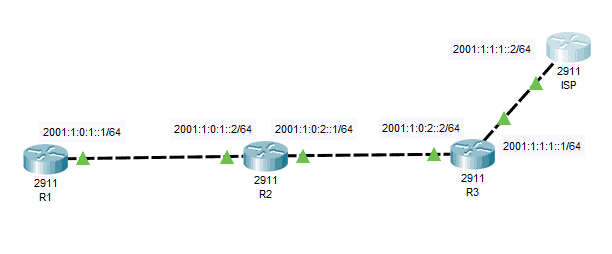Did you ever wonder how to efficiently connect the host or your workstation to the internet in terms of ease of configuration? One of the options is by using the default static route and summary route. In summary route configuration, we can be able to configure a static route for all the subnets within the LAN network with only one command only if within the same subnet. To connect the host inside the LAN, we need to configure default on the CPE (Customer Premise Equipment) point towards the ISP. In this article, you will learn the concept and configuration of the IPv6 default static route and summary route.
IPv6 Summary Route
A summary route is a route advertisement that lists a single route. The IP address range that matches that single route includes the same addresses in multiple other subnets in a router’s routing table. If there are many subnets on the network that needs a static route configuration on the CPE (R3), we will use a static summary route for ease of configuration. All the routes in the network are summarized on one subnet.
IPv6 Default Static Route
On the other hand, the default route is the gateway IP address where the router sends all of the IP packets that it does not have a learned or static route for. A default static route configured is simply a static route with ::/0 as the destination IPv6 address.
Connected and Local Routes
Similar to IPv4 routes, we also have Connected and Local routes, which are automatically added to the routing table. IPv6 local routes define the route for that one specific IPv6 address configured on the router interface. IPv6 local routes have a /128 prefix length which is used to specify their own local IPv6 addresses.
IPv6 connected routes are also automatically added to the routing table when there is a directly connected subnet on a router’s interface. Both ends of the directly connected link must have an IPv6 address configured and both interface status codes must be in the up state. The command ‘ipv6 unicast-routing’ must be also configured on the routers to enable IPv6 routing.
IPv6 Summary and Default Static Routing Configuration
We will configure the IPv6 default static route on R3 for the hosts, and routers inside the LAN can connect to the internet (ISP). We will use the below diagram as we proceed on configuring the IPv6 default static route and summary route.
1. Enable IPv6 on the global configuration of each router.
R1(config)#ipv6 unicast-routing
R2(config)#ipv6 unicast-routing
R3(config)#ipv6 unicast-routing
ISP(config)#ipv6 unicast-routing
2. Configure the IPv6 address on each interface of each router.
R1(config)#int g0/0 R1(config-if)#ipv6 add 2001:1:0:1::1/64 R1(config-if)#no shut
R2(config)#int g0/0 R2(config-if)#ipv6 add 2001:1:0:1::2/64 R2(config-if)#no shut R2(config-if)#int g0/1 R2(config-if)#ipv6 add 2001:1:0:2::1/64 R2(config-if)#no shut
R3(config)#int g0/0 R3(config-if)#ipv6 add 2001:1:0:2::2/64 R3(config-if)#no shut
ISP(config)#int g0/1 ISP(config-if)#ipv6 add 2001:1:1:1::1/64 ISP(config-if)#no shut
3. Configure IPv6 static route on R1 for the network 2001:1:0:2::/64 and 2001:1:1:1::/64 so that R2 will know the route R3 and ISP. We will use the next-hop address instead of the output interface.
R1(config)#ipv6 route 2001:1:0:2::/64 2001:1:0:1::2
R1(config)#ipv6 route 2001:1:1:1::/64 2001:1:0:1::2
4. Configure IPv6 static route on R2 for the network 2001:1:1:1::/64 so that R2 will know the route ISP.
R2(config)#ipv6 route 2001:1:1:1::/64 2001:1:0:2::2
5. Configure the IPv6 summary route on R3 for the route pointing to R1 and R2.
R3(config)#ipv6 route 2001:1:0::/48 2001:1:0:2::1
6. Configure IPv6 default static routing on R3 pointing all the unknown traffic (destination IPv6) to ISP. With this configuration, all the unknown destination networks will go to ISP.
R3(config)#ipv6 route ::/0 2001:1:1:1::2
7. Configure an IPv6 static route on ISP, a static route configuration from R1, R2, R3.
ISP(config)#ipv6 route ::/0 2001:1:1:1::1
Download our Free CCNA Study Guide PDF for complete notes on all the CCNA 200-301 exam topics in one book.
We recommend the Cisco CCNA Gold Bootcamp as your main CCNA training course. It’s the highest rated Cisco course online with an average rating of 4.8 from over 30,000 public reviews and is the gold standard in CCNA training:

